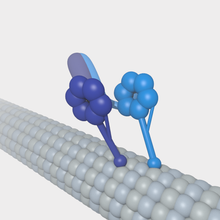Intracellular transport
This article needs additional citations for verification. (June 2017) |
Intracellular transport is the movement of

Intracellular transport is unique to eukaryotic cells because they possess organelles enclosed in membranes that need to be mediated for exchange of cargo to take place.
Fusion
Small membrane bound vesicles responsible for transporting proteins from one organelle to another are commonly found in endocytic and

Role of endocytosis
Intracellular transport is an overarching category of how cells obtain nutrients and signals. One very well understood form of intracellular transport is known as endocytosis. Endocytosis is defined as the uptake of material by the invagination of the plasma membrane.[4] More specifically, eukaryotic cells use endocytosis of the uptake of nutrients, down regulation of growth factor receptors’ and as a mass regulator of the signaling circuit. This method of transport is largely intercellular in lieu of uptake of large particles such as bacteria via phagocytosis in which a cell engulfs a solid particle to form an internal vesicle called a phagosome. However, many of these processes have an intracellular component.
Role of microtubules


The transport mechanism depends on the material being moved. Intracellular transport that requires quick movement will use an actin-myosin mechanism while more specialized functions require microtubules for transport.
Diseases
By understanding the components and mechanisms of intracellular transport it is possible to see its implication in diseases. Defects encompass improper sorting of cargo into transport carriers, vesicle budding, issues in movement of vesicles along cytoskeletal tracks, and fusion at the target membrane. Since the life cycle of the cell is a highly regulated and important process, if any component goes awry there is the possibility for deleterious effects. If the cell is unable to correctly execute components of the intracellular pathway there is the impending possibility for protein aggregates to form. Growing evidence supports the concept that deficits in axonal transport contributes to pathogenesis in multiple neurodegenerative diseases. It is proposed that protein aggregations due to faulty transport is a leading cause of the development of

On the other hand, targeting the intracellular transport processes of these motor proteins constitutes the possibility for pharmacological targeting of drugs. By understanding the method in which substances move along neurons or microtubules it is possible to target specific pathways for disease. Currently, many drug companies are aiming to utilize the trajectory of intracellular transport mechanisms to deliver drugs to localized regions and target cells without harming healthy neighboring cells. The potential for this type of treatment in anti-cancer drugs is an exciting, promising area of research.
See also
- Transport by multiple-motor proteins
- Kinesin
- Adaptor protein
- Leelamine
- Dynactin
- MCOLN2
- KIF6, KIF5A, involved in intracellular organelle transport
- COG2, COG4, COG5, COG7
- Sterol carrier protein
References
- ^ PMID 28461574.
- PMID 18946473.
- ^ OCLC 1048014962.)
{{cite book}}: CS1 maint: location missing publisher (link - ^ ISBN 978-0-7167-3136-8.
- PMID 26416952.
- ^ The Cell: A Molecular Approach.
- PMID 16730956.
